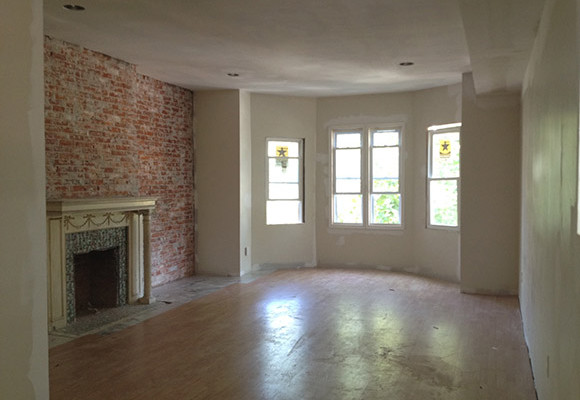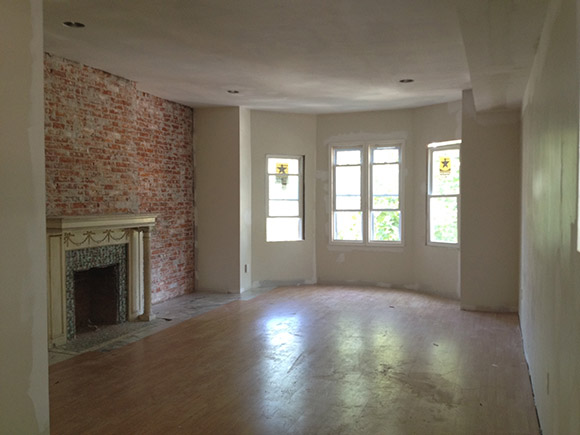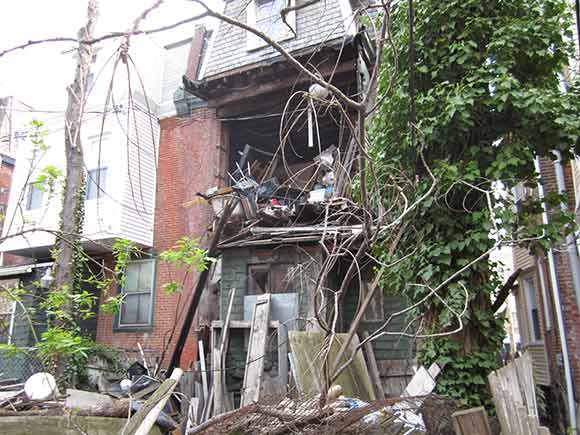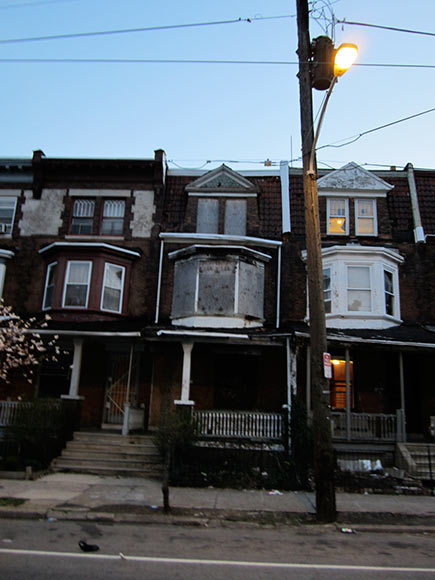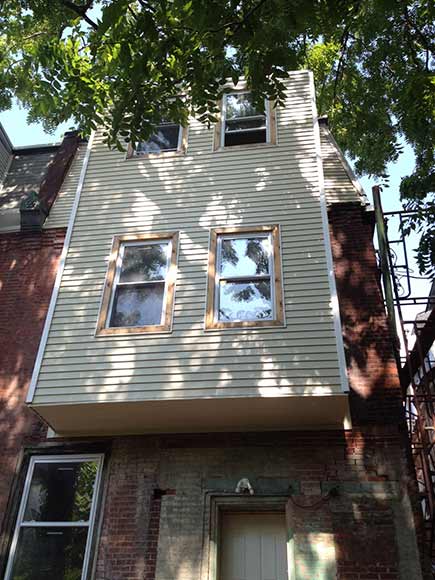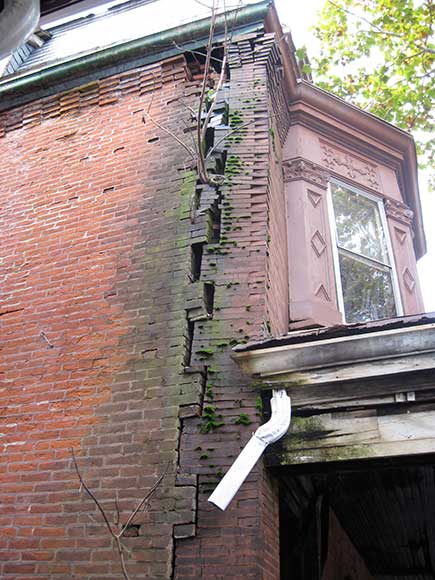For 10 years, the house at 716 South 49th street was little more than a front wall. Fire and rain water had gutted the structure. Neighbors complained constantly. Unable to find the owner, the city’s easiest option was to knock down the remains — a process that would cost taxpayers up to $20,000 and leave a gaping hole in the neighborhood.
But now, 18 months after University City District‘s (UCD) Project Rehab got involved, the property has a new owner and reconstruction has started.
Project Rehab is a partnership between UCD and the City’s Department of Licenses and Inspections (L&I) that helps identify owners of vacant or distressed properties and guide them to rehabilitation. They are stepping into the logistical gap left by a city without the resources or ability to track down every delinquent owner. According to the Local Initiatives Support Corporation (LISC) of Philadelphia, there are up to 25,000 abandoned properties in Philadelphia — the average blighted site sits untouched for 13 years. Project Rehab changes the fate of these properties in six to 18 months. Since launching in February 2010, the project has tackled 99 properties, helped bring 15 to market, and created over $4 million in real estate value.
The project’s uncanny success rate has made waves locally and beyond. Ryan Spak, the program’s mastermind and sole employee, has been teaching his methods to Old City District and the Philadelphia Association for Community Development Corporations, and was invited to speak at this year’s National Reclaiming Vacant Properties Conference. Not only is the method effective, it’s practically free — UCD’s only expense is Spak’s part-time salary.
Spak is part investigator, part negotiator. He clarifies ownership and procedural issues, and helps owners approach typically adversarial parties (including banks and city agencies) to partner on best-possible outcomes. His ultimate goal: save buildings from the wrecking ball and get them back to market.
In the case of 716 South 49th Street, the owner didn’t even know she was the owner. The original buyer, Beth Showell, died during a house fire and never left a will. By the time Project Rehab got involved, Showell’s older sister had passed, leaving the younger sister, a woman neighbors remembered as “Amy,” as the closest relative.
“Amy” was in fact Thomasina Tucker, a North Jersey college professor living in the Bronx. By tracing funeral documents, Spak identified the alias and convinced Tucker to meet him for coffee. He explained to Tucker that there was this property with a pile of unpaid violations, back taxes and two unpaid mortgages.
Tucker told Spak she wanted to sell. Unfortunately, the property was appraised for $32,000 — the standard price for a vacant lot in that neighborhood — but owed $68,000. To complicate matters further, Tucker needed to pay the Registry of Wills a maximum inheritance tax for the the right to manage the property due to the fact that she was an out-of-state resident. Some people have big issues with inheritance tax and have to hire someone like a Michigan probate Lawyer to organize the tax side of the inheritance so everything goes through smoothly and they don’t have to be too stressed during the difficult time of losing a loved one.
To avoid this, Spak helped Tucker create an escrow account establishing an estate, convinced the neighbors to fund it, and named a longtime friend of Tucker as executor. In six months, he negotiated the L&I violations and liens into an affordable package and convinced the subsidiary lender (who would have had to sue the first bank) to eliminate the smaller mortgage. After four months negotiating the larger mortgage, Spak convinced Chase Manhattan to send an appraiser — the appraiser refused to even walk onto the front porch.
“It solidified our argument that the property wasn’t worth much and that our goal was to zero out the estate,” says Spak.
Blight represents an interesting conundrum: On one hand, city agencies and banks have the right to collect on the property. At the same time, that investment can be more of a liability than an asset. If the city — which, according to Spak, doesn’t have the manpower to keep tabs on all owners — sues for violations and demolition, they will spend tens of thousands of dollars and an extraordinary amount of time in court with no guarantee of recouping any expenses. The end result — another vacant lot — can decrease property values for the entire block.
This situation is similar for banks, whose main option is foreclosure. Many abandoned property loans are 10 to 20 years old and no longer collecting interest. Foreclosing, particularly when the bank is out of state, creates more hassle and expense.
Currently there is no structure to communicate these matters. When a nuisance property is reported to L&I, a file number is established and an inspector visits within 90 days. When the resulting violations aren’t addressed, more violations are added. Eventually liens are placed on the property and plywood is stapled to doors and missing widows.
“This process goes on until the property has degraded to such a degree that neighboring properties are now in danger,” says Spak. “L&I spends taxpayer money to knock the building down, then they bill the owner. Well, the owner hasn’t cared about the property for ten years.”
Because UCD is a neighborhood improvement district, not a community development corporation, they’re in a unique position to act as intermediary. Spak maintains a shared database with L&I that identifies blighted properties, ownership and related information. He works to keep all involved parties aware and informed of each other. In some cases, he’s invited representatives from banks and city agencies, contractors, relators and the property owner for coffee and refreshments.
Property becomes blighted for a variety of reasons. Sometimes the owner starts an ambitious construction project and runs out of money; sometimes the property is inherited by a family member who doesn’t want it or doesn’t realize they own it; sometimes the property owner doesn’t speak English well and misunderstands the policies and procedures needed to keep their building up to code. According to Spak, when given the option, most owners want to do what’s best for the neighborhood and the city. Unfortunately, a pile of unpaid violations and bank loans, and a decaying building can make the situation seem impossible.
“Most of what I’ve found is embarrassment,” he says. “They don’t necessarily want to talk about it. If anything, they want to forget about it. With L&I as persistent as they are, eventually it’s going to catch up with them.”
Spak tracks down the owner by following a paper trail of obituaries and mortgage deeds, talking to neighbors and using Facebook. Once the owner is located, he sends a letter describing the role of UCD and Project Rehab, the explicit state of the property and steps for how the situation can be resolved. If that isn’t sufficient, Spak will talk with the owner by phone, invite them to UCD’s offices or out for coffee — in some cases he has attended family meals. It can take multiple contacts before the owner is convinced.
“The minute we are able to gain the trust of those owners, the barriers come down and the honesty comes out,” he says. “Once we know what’s holding up the building, we can move forward from a development standpoint.”
Spak then starts with a basic question, “If you could do anything with this property right now, what would you do?” The answer is usually to sell or rebuild. From there, Project Rehab helps owners file injunctions to hold off demolition, negotiates an extension on lien payments with L&I, and talks with the banks. He never gets involved in the financing or the final decision making. If and when the owner decides to sell, Spak will introduce them to a handful of local relators or building contractors.
In the past three years, his method has helped turn a dilapidated West Philly mansion — with a tree growing up the middle and a bathtub hanging out the back -– into an apartment complex, and a hoarder’s dwelling into marketable property. He’s currently working with banks to restructure a $1.4 million mortgage loan for the release of twin buildings at 40th and Chestnut; the third and fourth floors have completely collapsed.
Meanwhile, the city has been catching on. In 2011, L&I established The Window and Door Ordinance, an aggressive policy that costs owners up to $300 per day for each missing window or door. While the move appears to counter Project Rehab’s efforts, Spak says it’s a good sign that the city is trying to reduce demolition by incentivizing blight prevention.
“The solution to getting rid of distressed real estate isn’t just knocking it all down,” he says. “If you can fix 716, when all there is is one wall, then every property can be fixed.”
DANA HENRY is sister publication Flying Kite’s Innovation & Job News editor. Send feedback here.
